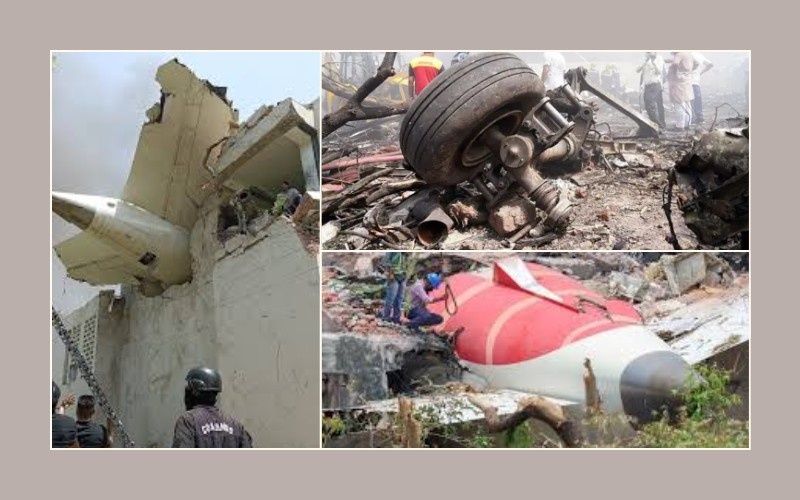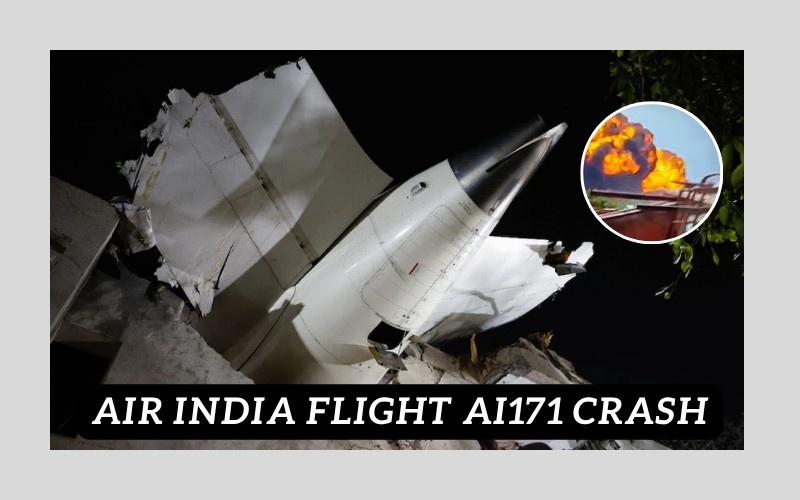Air India Flight AI171 was a Boeing 787-8 Dreamliner, and it flew the flight from Ahmedabad to London Gatwick, where it crashed just after takeoff, taking away the lives of nearly everyone onboard and dozens of people on the ground and on June 12, 2025, this event sent a shockwave across India. People are terming it as the worst aviation incident that happened in India, and the consequences of the accident have brought about some stiff conversation around aircraft safety, crisis management, and regulatory oversight in Indian aviation.
The Flight That Never Took Off
At 1:38 PM IST, AI171 left Ahmedabad Sardar Vallabhbhai Patel International Airport. It had 230 passengers and 12 crew members representing the UK, Canada, the U.S., and other regions of India. This is demonstrated by the airplane starting to stall within the space of a small duration, less than 30 seconds of flying time, at a small altitude (slightly higher than 625 feet). It went down in a very short time and ended up striking the buildings of the hostel and the canteen of the B.J. Medical College, which is close to the airport.
Eyewitnesses report having heard a thunderous sound with an explosion as the buildings were covered with flames. The heart-stopping final seconds of the jet crashing at an abnormal low altitude and disappearing in a fireball were captured by the security cameras in the surrounding settings. Rescue and fire brigades were sent out in a matter of minutes, yet the extent of destruction was already enormous.
Devastating Loss of Life
Of the 242 on board, 241 were reported dead, which led to one of the worst crashes to have happened to Indian aviation. A 34-year-old British of Indian origin, Vishwash Kumar Ramesh, who was sitting in 11 A, was the only one to survive. It is reported that he somehow managed to get out via a side emergency exit door that came off the hinges on impact. He has received minor injuries and has been shifted to the Civil Hospital.
The number of deaths did not end with the flight itself. The impact of the crash led to terrible devastation on the ground, particularly in the canteen and hostel premises of B.J. Medical College, which were being used at the time. Hospital officials and the state government of Gujarat put the number of those killed on the ground, most of them medical students and employees, at least 28, with another 50 injured, some in critical condition. At the hospital, families of the victims arrived, mourning, with many not believing what had happened.
Early Investigation and Black Box Recovery
The Indian Aircraft Accident Investigation Bureau (AAIB) promptly started an investigation, as usual, accompanied by international experts, the U.S. National Transportation Safety Board (NTSB), Federal Aviation Administration (FAA), Boeing, and GE Aerospace, maker of the engines used on the plane. It managed to retrieve one of the flight data recorders (black boxes) on the same day, and the cockpit voice recorder was located the following morning.
An early indication of flight data records indicates a loss of engine thrust soon after takeoff. The plane might have failed to develop enough speed and lift, possibly owing to the wrong flap configuration or autothrottle incapacitation. A technical malfunction is not being ruled out by the investigators, but the final report might take weeks or months.
Specialists also mentioned that the landing gear was still down on the airplane, and flaps might not have been set correctly. The video analysts indicated discrepancies in the pitch attitude of the plane and its takeoff path. This will be compared and contrasted with the information in the black boxes to get the actual sequence of events.
A First for the Boeing 787 Dreamliner
This is the first fatal accident involving a Boeing 787 Dreamliner in the history of this plane, which has the characteristics of fuel-efficient engines, a composite body, and long-range. Its 787 debuted in 2011 and had flown millions of hours without a serious crash anywhere in the world until now. The involved aircraft, registration VT-ANB, was an aircraft in the legacy fleet of Air India and had more than 12 years of service.
This incident has been described as unthinkable by aviation analysts concerning the Dreamliner. This issue comes at a bad time for Boeing, which is already under scrutiny by regulators regarding its previous manufacturing issues with the 737 MAX line, as now, its 787 series is under question. It is currently speculated that India might ground all of its Boeing 787-8 until further safety inspections can be carried out.
Government and Airline Response
This is the first ever crash history of a Boeing 787 Dreamliner, the first aircraft that is characterized by the ability to save on fuel consumption, a composite body, and a long-range capacity. The 787, which was introduced in 2011, had already flown millions of hours without a serious accident anywhere in the world up to this moment. The involved aircraft, registration VT-ANB, was an aircraft in the legacy fleet of Air India and had more than 12 years of service.
This incident has been described as unthinkable by aviation analysts concerning the Dreamliner. This issue comes at a bad time for Boeing, which is already under scrutiny by regulators regarding its previous manufacturing issues with the 737 MAX line, as now, its 787 series is under question. It is currently speculated that India might ground all of its Boeing 787-8 until further safety inspections can be carried out.

The Lone Survivor: Vishwash Kumar’s Story
A London-based marketing executive, Vishwash Kumar Ramesh, who was in Gujarat to visit relatives, was amongst the few rays of hope in an otherwise dark incident as he survived. On the left wing, where he was seated and near the emergency exit, he described how it was a frightening moment as the plane shook and plunged before a loud crash.
I only remember the fire and the screams, not the fall. I must have been tossed out or broken through a busted side door, he told doctors. His seat, 11A, was possibly the closest to a fuselage breach. He received minor cuts and was otherwise transferred to a private hospital to recover psychologically. The story of Vishwash and his miraculous escape has been covered extensively by the Indian and International media.
Safety Under Scrutiny: India’s Growing Aviation Burden
The aviation industry in India has seen mind-blowing growth in the last decade. The pressure on its airports, carriers, and regulatory agencies to grow safely has never been more tense, and it is projected that there will be over 500 million passengers in 2027. However, this tragedy displays some unresolved weaknesses.
The critics claim that the Directorate General of Civil Aviation (DGCA) should do better to:
Require engine health monitoring in real time.
Carry out regular unexpected audits.
Adopt Artificial Intelligence-based predictive maintenance.e
Develop enhanced flight simulation and emergency training for pilots
The airport facilities in India, particularly in the congested metropolitan areas such as Ahmedabad, are also under question. There has always been a concern over the closeness of civilian structures to the flight paths. There are increasing demands for zoning changes and the creation of more buffer zones near runways and taxiways.
Media Coverage and Public Outrage
The crash made news in India and overseas. Such hashtags as #AirIndiaCrash, #AI171, and #PrayForAhmedabad were trending on social media. Netizens were raising not only the safety of aircraft but also other wider questions, such as ground support, pilot exhaustion, and the age of aircraft in national fleets.
Although Air India received applause due to its prompt response after the crash, there were a lot of accusations towards the government why it did not mandating that such older aircraft undergo independent technical audits. Experts and influencers in the field of aviation released explainer articles and increased the level of awareness regarding aircraft types, stall phenomena, and risks of aviation in developing nations.
What Happens Next: The Road to Justice and Reform
A preliminary report is expected to be released by AAIB and DGCA within 30 days, and a full technical report is expected in 3–6 months. In the meantime, several emergency steps are expected:
Thorough inspection of all Dreamliners in India.
One of them is grounding certain aircraft until maintenance is reviewed.
Short-term alterations of routes in the flight paths around busy urban areas.
New security warnings to all Indian airlines.
Boeing is also likely to experience legal problems internationally, particularly among the families of foreign victims. The Ministry of Civil Aviation of India will also tend to insist on a new National Air Safety Framework that can enforce superior standards of operation and technical excellence.
Remembering the Lost: Stories of Those Onboard
When the manifest was published, wrenching stories came out:
- They are a newlywed couple from Gujarat on a honeymoon in London.
- Doctors involved in the incident are living in the UK and they came home after a wedding.
- Indian Students. This was a set of Indian Students who had come to visit the university in Europe and had attended a summer program.
Among the dead are citizens of the UK, Canada, and Australia, thus prompting international grief. The tragic loss of life caused by such a great number of people was mourned by the world, and candlelight vigils were held in Ahmedabad, Delhi, and even London, as the system failure is still being unraveled.
Conclusion: A Wake-Up Call at 625 Feet
Air India AI171 crash remains a gruesome reminder that in aviation, details do count. Whether it is a maintenance check or a decision taken by the pilots, whether it is an airport infrastructure or a manufacturer design, every link in the chain has to work perfectly. A single link failure can cause a state-of-the-art plane to fall within a few seconds, which is the case here.
With India poised to take the aviation industry to the next level in the upcoming years, this tragedy should act as an eye-opener. Not only to Air India or Tata or Boeing, but to the country and the world of aviation. The deaths should not go in vain. Their tales have to be the ones that force change, vigilance, and an unending quest to ensure air safety since the skies can no longer be allowed to turn into a graveyard once more.













